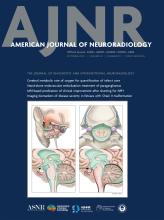Research ArticleNeurovascular/Stroke Imaging
Hypoperfusion Intensity Ratio and Hemorrhagic Transformation in Patients with Successful Recanalization after Thrombectomy
Jiaxiang You, Xiaoxi Li, Jun Xia, Haopeng Li and Jun Wang
American Journal of Neuroradiology October 2024, 45 (10) 1475-1481; DOI: https://doi.org/10.3174/ajnr.A8329
Jiaxiang You
aFrom the Department of Emergency Medicine (J.Y., J.X., H.L., J.W.), Nanjing Drum Tower Hospital Clinical College of Xuzhou Medical University, Nanjing, China
Xiaoxi Li
bDepartment of Emergency Medicine (X.L., J.W.), Nanjing Drum Tower Hospital, The Affiliated Hospital of Nanjing University Medical School, Nanjing, China
Jun Xia
aFrom the Department of Emergency Medicine (J.Y., J.X., H.L., J.W.), Nanjing Drum Tower Hospital Clinical College of Xuzhou Medical University, Nanjing, China
Haopeng Li
aFrom the Department of Emergency Medicine (J.Y., J.X., H.L., J.W.), Nanjing Drum Tower Hospital Clinical College of Xuzhou Medical University, Nanjing, China
Jun Wang
aFrom the Department of Emergency Medicine (J.Y., J.X., H.L., J.W.), Nanjing Drum Tower Hospital Clinical College of Xuzhou Medical University, Nanjing, China
bDepartment of Emergency Medicine (X.L., J.W.), Nanjing Drum Tower Hospital, The Affiliated Hospital of Nanjing University Medical School, Nanjing, China

References
- 1.↵
- Ni H,
- Lu GD,
- Hang Y, et al
- 2.↵
- 3.↵
- 4.↵
- 5.↵
- 6.↵
- Olivot JM,
- Mlynash M,
- Inoue M, et al
- 7.↵
- 8.↵
- 9.↵
- 10.↵
- Ghozy S,
- Kacimi SEO,
- Azzam AY, et al
- 11.↵
- 12.↵
- 13.↵
- 14.↵
- Sarraj A,
- Albers GW,
- Mitchell PJ, et al
- 15.↵
- Hacke W,
- Kaste M,
- Fieschi C, et al
- 16.↵
- Tsui B,
- Chen IE,
- Nour M, et al
- 17.↵
- 18.↵
- Lyndon D,
- van den Broek M,
- Niu B, et al
- 19.↵
- 20.↵
- Lin L,
- Yang J,
- Chen C, et al
- 21.↵
- 22.↵
- 23.↵
- Hashimoto T,
- Kunieda T,
- Honda T, et al
- 24.↵
- 25.↵
- Little JR,
- Kerr FW,
- Sundt TM. Jr,.
- 26.↵
- 27.↵
- 28.↵
- 29.↵
- 30.↵
- 31.↵
- 32.↵
- 33.↵
- 34.↵
- Fanou EM,
- Knight J,
- Aviv RI, et al
- 35.↵
- Hornig CR,
- Bauer T,
- Simon C, et al
- 36.↵
- 37.↵
- Kamel H,
- Healey JS
- 38.↵
In this issue
American Journal of Neuroradiology
Vol. 45, Issue 10
1 Oct 2024
Advertisement
Jiaxiang You, Xiaoxi Li, Jun Xia, Haopeng Li, Jun Wang
Hypoperfusion Intensity Ratio and Hemorrhagic Transformation in Patients with Successful Recanalization after Thrombectomy
American Journal of Neuroradiology Oct 2024, 45 (10) 1475-1481; DOI: 10.3174/ajnr.A8329
0 Responses
Jump to section
Related Articles
Cited By...
- No citing articles found.
This article has not yet been cited by articles in journals that are participating in Crossref Cited-by Linking.
More in this TOC Section
Neurovascular/Stroke Imaging
Similar Articles
Advertisement











